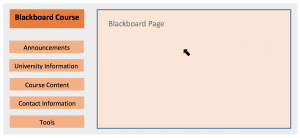For the final assignment I chose to do a Case Study, rather than a Final Synthesis. Although, if you are interested in my final synthesis, you can check out my video recording in Connect, or navigate to the link below:
https://www.youtube.com/watch?v=FT9Basdt8tc&t=203s
Here is my Case Study:
Jennie is a member of the support staff in the faculty of Advancing Education at Fields University in Alberta, Canada. Jennie works in the Blackboard LMS (Learning Management System) to help set up courses for busy contract instructors. While Jennie has an educational background in instructional design, her options for course design within the Blackboard LMS are limited.
Even though many of the contract instructors that Jennie helps to manage are keen to experiment and try new layouts within their Blackboard sites, the faculty of Advancing Education has policies in place that restrict the Blackboard course designs to the following pages, accessible through the course menu tabs:

As it is currently designed, all course content must be under the Course Content tab/page. The University Information page is designated for general university information including information on accessing the library, as well as resources to visit for copyright information. The Contact Information page is for instructor and department contact information, and the Tools page is for university tools including internal email, course grades, etc. Other than the Announcements page and the Course Content page, all Blackboard courses in the Advancing Education department have the same layout for their LMS sites.
Jennie is frustrated that all course content must exist within the Course Content page, as she believes that this is poor instructional design. She often receives feedback from students and instructors that it would be beneficial to include a tab for Discussion Boards, or for an Assignment Dropbox. Having to place everything within folders in the Course Content page leaves students searching for specific content and she frequently hears that students have missed critical information from the feedback she receives from her instructors.
What can Jennie do to help tackle the issue of students who are missing information because of the condensed nature of the LMS layout requirements? Is there anything that Jennie can do with instructional design within the constraints she has been given? Additionally, is there anything that Jennie can do to help convince her department that the layout would benefit from changes?
Thanks for a great term everyone!